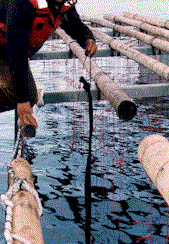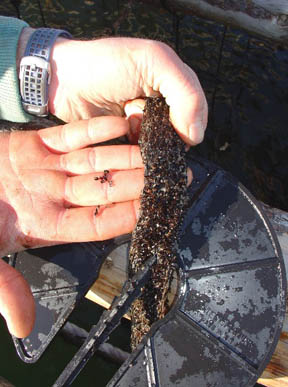Natural Seeding of Mussels
We attempt to take advantage of the natural spawning cycle of the mussels in Penn Cove which culminates about the month of May of each year as the water temperatures begin to climb.
In the early spring we suspend tens of thousands of fibrous lines from the mussel rafts anchored in Penn Cove. Each of our 42 rafts (40' x 80', 40' x 120', and 30' x 90' each), will hold approximately 1300-2400 of these mussel seed collector lines.

Left - A mussel seed collector line suspended from a raft floating in Penn Cove. Thousands of these lines are put out in the early spring of each year to collect the swimming larvae from the mussels which spawn in Penn Cove.
When the conditions are right, the male and female mussels spawn releasing their eggs and sperm into the water where the eggs are immediately fertilized. The fertilized eggs become swimming larvae within a 24 hour period and remain so for a 3 week time span, at which time they go through another change where they develop their shell and other organs. At this point they are ready to settle on something in the intertidal area; hopefully on the seed collector lines which are hanging from our mussel rafts.
As the mussel seed goes through its change from a swimming larvae to its shelled form, it develops a foot similar to a clam. However, on the base of the foot there is a gland which secretes a very strong cement to whatever it attaches itself to. When the small mussel (1/3 of a millimeter), is ready to settle on a solid substrate, it puts out its foot and applies a dab of cement to the seed collector lines which we have hanging from the mussel rafts in the top 3 meters of the water.
After about three weeks of growing on the mussel collector lines, the small mussels become visible, this is normally in the first week of June. In a normal year, one can see literally thousands of these tiny mussels on each meter of a collector line.

Right - A seed collector, about three months old. Note the heavy density of the mussels on the collector. Once grown out to a more manageable size, this mussel seed will be stripped from this line and loaded into mussel socks at the proper density of about 200 per foot.
Once attached to the line, the mussel pulls its foot back creating a thread of the cement which hardens on contact with the sea water, somewhat similar to the manner in which a spider makes its web. The mussel will continue to put out these "byssal threads" until it is securely attached to the line. At that point it has pretty much found its home for life, although it can use its foot to attach to something nearby and still move a little bit. Once settled the mussels begin to feed.
